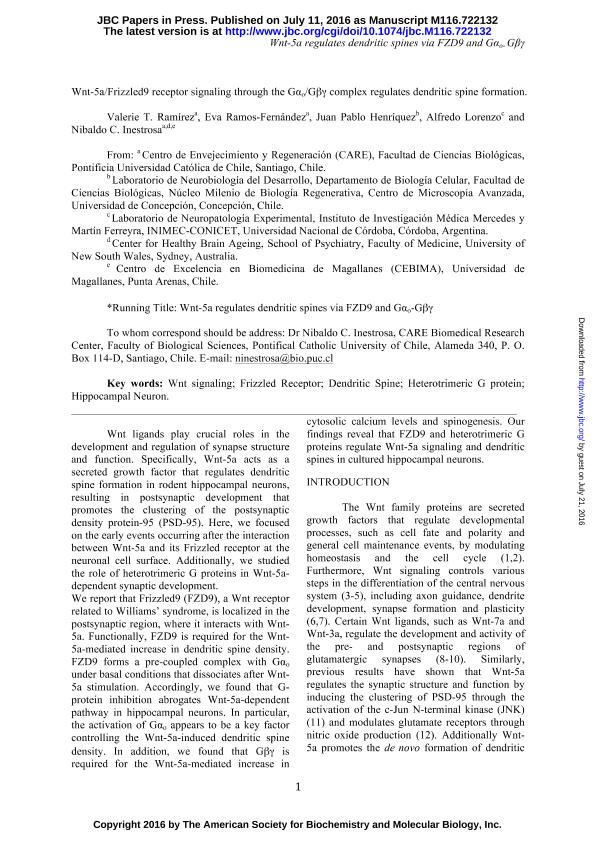Mostrar el registro sencillo del ítem
dc.contributor.author
Ramírez, Valerie T.
dc.contributor.author
Ramos-Fernandez, Eva
dc.contributor.author
Henriquez, Juan Pablo
dc.contributor.author
Lorenzo, Alfredo Guillermo

dc.contributor.author
Inestrosa, Nibaldo C.
dc.date.available
2019-05-20T17:51:23Z
dc.date.issued
2016-09
dc.identifier.citation
Ramírez, Valerie T.; Ramos-Fernandez, Eva; Henriquez, Juan Pablo; Lorenzo, Alfredo Guillermo; Inestrosa, Nibaldo C.; Wnt-5a/frizzled9 receptor signaling through the Gαo-Gβγ complex regulates dendritic spine formation; American Society for Biochemistry and Molecular Biology; Journal of Biological Chemistry (online); 291; 36; 9-2016; 19092-19107
dc.identifier.issn
0021-9258
dc.identifier.uri
http://hdl.handle.net/11336/76714
dc.description.abstract
Wnt ligands play crucial roles in the development and regulation of synapse structure and function. Specifically, Wnt-5a acts as a secreted growth factor that regulates dendritic spine formation in rodent hippocampal neurons, resulting in postsynaptic development that promotes the clustering of the PSD-95 (postsynaptic density protein 95). Here, we focused on the early events occurring after the interaction between Wnt-5a and its Frizzled receptor at the neuronal cell surface. Additionally, we studied the role of heterotrimeric G proteins in Wnt-5a-dependent synaptic development. We report that FZD9 (Frizzled9), a Wnt receptor related to Williams syndrome, is localized in the postsynaptic region, where it interacts with Wnt-5a. Functionally, FZD9 is required for the Wnt-5a-mediated increase in dendritic spine density. FZD9 forms a precoupled complex with Gαounder basal conditions that dissociates after Wnt-5a stimulation. Accordingly, we found that G protein inhibition abrogates the Wnt-5a-dependent pathway in hippocampal neurons. In particular, the activation of Gαoappears to be a key factor controlling the Wnt-5a-induced dendritic spine density. In addition, we found that Gβγ is required for the Wnt-5a-mediated increase in cytosolic calcium levels and spinogenesis. Our findings reveal that FZD9 and heterotrimeric G proteins regulate Wnt-5a signaling and dendritic spines in cultured hippocampal neurons.
dc.format
application/pdf
dc.language.iso
eng
dc.publisher
American Society for Biochemistry and Molecular Biology

dc.rights
info:eu-repo/semantics/openAccess
dc.rights.uri
https://creativecommons.org/licenses/by-nc-sa/2.5/ar/
dc.subject
Wnt Signaling
dc.subject
Frizzled Receptor
dc.subject
Dendritic Spine
dc.subject
Heterotrimeric G Protein
dc.subject.classification
Otras Ciencias Biológicas

dc.subject.classification
Ciencias Biológicas

dc.subject.classification
CIENCIAS NATURALES Y EXACTAS

dc.title
Wnt-5a/frizzled9 receptor signaling through the Gαo-Gβγ complex regulates dendritic spine formation
dc.type
info:eu-repo/semantics/article
dc.type
info:ar-repo/semantics/artículo
dc.type
info:eu-repo/semantics/publishedVersion
dc.date.updated
2019-04-15T18:14:20Z
dc.identifier.eissn
1083-351X
dc.journal.volume
291
dc.journal.number
36
dc.journal.pagination
19092-19107
dc.journal.pais
Estados Unidos

dc.journal.ciudad
Bethesda
dc.description.fil
Fil: Ramírez, Valerie T.. Pontificia Universidad Católica de Chile; Chile
dc.description.fil
Fil: Ramos-Fernandez, Eva. Pontificia Universidad Católica de Chile; Chile
dc.description.fil
Fil: Henriquez, Juan Pablo. Universidad de Concepción; Chile
dc.description.fil
Fil: Lorenzo, Alfredo Guillermo. Consejo Nacional de Investigaciones Científicas y Técnicas. Centro Científico Tecnológico Conicet - Córdoba. Instituto de Investigación Médica Mercedes y Martín Ferreyra. Universidad Nacional de Córdoba. Instituto de Investigación Médica Mercedes y Martín Ferreyra; Argentina
dc.description.fil
Fil: Inestrosa, Nibaldo C.. Pontificia Universidad Católica de Chile; Chile
dc.journal.title
Journal of Biological Chemistry (online)

dc.relation.alternativeid
info:eu-repo/semantics/altIdentifier/doi/http://dx.doi.org/10.1074/jbc.M116.722132
dc.relation.alternativeid
info:eu-repo/semantics/altIdentifier/url/https://www.ncbi.nlm.nih.gov/pubmed/27402827
Archivos asociados
